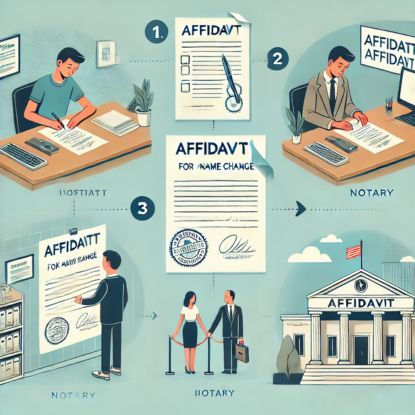How to Get Affidavit for Name Change

Date : 17 Dec, 2024
Post By admin
Navigating the name change process can feel overwhelming, but understanding how to obtain an affidavit simplifies this journey. Individuals begin by gathering essential documents, including identification and proof of their reason for the name change. They then complete a specific affidavit form, often available online or through local legal resources. After filling out the form, they may need to have it notarized before submitting it to the appropriate court or agency, ensuring compliance with any requirements set forth by their jurisdiction. This approach empowers individuals and reinforces their confidence as they take steps toward embracing their new identity.
What an Affidavit Means Legally
An affidavit is a legal document that serves as a written declaration made under oath, providing factual evidence to the courts. In name changes, this document affirms your identity and intentions regarding a new name. Its importance lies in functioning as credible proof when requesting recognition of your chosen name from authorities.
Legally, an affidavit simplifies complex proceedings. By submitting this sworn statement with other required documents, you formalize your identity change. It supports your petition for a name change and clarifies your current identity and reasons for the transition.
The implications of this documentation extend beyond personal preference; they affect social security benefits, employment opportunities, and financial matters where names must match official records. An accurate Affidavit eliminates ambiguity about your intent or past identity during processes involving banks or government agencies, facilitating seamless transitions across various sectors.
Navigating these legal waters may seem daunting; yet, understanding what an affidavit represents empowers you throughout this journey. Clear guidance on preparing one effectively and fulfilling local requirements ensures each step reinforces your confidence and trustworthiness toward officials managing these requests.
Common Motivations for Changing Your Name
1. Changing your name can arise from various motivations, each personal and significant.
1.1 Marriage prompts the decision to adopt a partner's surname as a symbol of unity.
1.2 Divorce often leads individuals to reclaim their maiden names, restoring an identity tied to their past.
1.3 Personal preference plays a role:
1.3.1 Some individuals choose names that resonate more authentically with who they are.
1.3.2 Others select names to reflect the person they wish to become.
1.4 Cultural or religious factors also influence the decision:
1.4.1 Selecting names to honor one’s heritage.
1.4.2 Choosing names that align with spiritual or religious beliefs to add meaning to life.
2. These motivations reflect not just administrative changes but journeys toward authenticity and self-expression.
2.1 Each reason carries emotional weight.
2.2 Understanding your motivations clarifies intentions when preparing documents like an affidavit.
2.3 Thoughtful reflection about your desired name:
2.3.1 Provides clarity.
2.3.2 Builds confidence for navigating legal requirements.
3. Changing one’s name signifies more than logistics—it represents transformation and new beginnings.
3.1 This transformation is filled with hope and possibility.
3.2 Embracing these feelings empowers you as you:
3.2.1 Take steps to reaffirm your identity.
3.2.2 Align your identity with your true desires within society.
Key Steps to Meet Local Laws
1. Familiarizing yourself with local laws is essential before starting the name change process.
1.1 Research your jurisdiction’s requirements as they can vary significantly between states or counties.
1.2 Utilize online resources to:
1.2.1 Understand eligibility criteria.
1.2.2 Identify required forms for submission.
1.2.3 Determine potential fees for filing your affidavit for a name change.
1.3 Be aware of additional steps that some jurisdictions may require:
1.3.1 Notifying interested parties.
1.3.2 Undergoing background checks.
1.4 Knowing these details will:
1.4.1 Streamline your experience.
1.4.2 Minimize unnecessary delays.
2. Once you’ve gathered all necessary information and documents, prepare your petition alongside the affidavit.
2.1 Accurately complete all mandated forms according to local guidelines.
2.2 Errors at this stage could lead to:
2.2.1 Complications in the process.
2.2.2 Potential delays in approval.
2.3 Be aware of deadlines related to public notice requirements:
2.3.1 Publish an announcement of your intended name change.
2.3.2 Follow designated newspaper guidelines for several weeks prior to court approval.
3. Careful attention at this stage ensures compliance and builds confidence as you proceed.
3.1 Reinforce legal compliance by adhering to local laws.
3.2 Move forward toward officially adopting your new identity with:
3.2.1 Preparedness.
3.2.2 Confidence in your process.
Essential Information to Include
When preparing your affidavit for a name change, include specific details that clearly present your case. Start with your current legal name and the new name you wish to adopt. Briefly outline the reason for the change—whether due to marriage, divorce, personal preference, or cultural significance. This context conveys the importance of your request. Incorporate an affirmation statement attesting that all information provided is accurate.
Understand any required forms in addition to the affidavit. Complete a Name Change Petition Form, which typically asks for essential personal data like date of birth and address along with reasons for the change. Depending on local regulations, there may be designated formats for these documents; adhering to them will prevent unnecessary delays.
Document additional requirements mandated by your jurisdiction when filing these papers. Some areas require notice publication regarding your intended name change in local newspapers for several weeks prior to court approval. Keeping track of such obligations ensures compliance and clarity throughout the process toward achieving recognition under a new identity.
Steps to Secure Your Name Change Affidavit
| Aspect | Details | Examples/Notes | Legal Requirements | Documentation Needed | Additional Considerations |
|---|---|---|---|---|---|
| Understanding the Affidavit | A written statement confirmed by oath or affirmation, used as evidence in court. | Serves as proof of identity and intent to change name. | Varies by state; check local laws. | Current legal name, desired name. | Emotional support during the process. |
| Reasons for Name Change | Common reasons include marriage, divorce, personal preference, cultural or religious reasons. | Adoption of spouse's surname, reverting to maiden name. | Eligibility criteria set by jurisdiction. | Reason for change must be specified. | Long-term implications on reputation. |
| Preparing Your Affidavit | Include your current name, desired name, reason for change, and an affirmation statement. | Affirmation that all information is true and correct. | Must meet local guidelines. | Affidavit form (if applicable). | Potential objections during proceedings. |
| Filing Your Documents | File petition and documents with the appropriate court and pay required fees. | Family or civil court filing. | Fees vary by jurisdiction. | Name change petition form. | Check publication requirements locally. |
| Court Hearing | Attend a hearing if required, present case before a judge, and answer questions. | Be prepared with additional documentation if needed. | Judge approval needed for finalization. | Certified copies of court order. | Prepare for possible challenges. |
| Updating Identification Documents | Update Social Security card, driver's license, passport, bank accounts, etc. | Each agency has its own requirements. | Proof of legal name change required. | Keep multiple certified copies of order. | Engage support systems for reassurance. |
Forms Needed for Your Application
- Gather essential forms and documents, including your current legal name and the new name you wish to adopt.
- Prepare the Name Change Petition Form with details like your date of birth, address, and reasons for the name change.
- Check local regulations, as requirements may vary by jurisdiction.
- Include supporting documents such as marriage certificates or other relevant proof for the name change.
- Be aware of publication requirements, like announcing your intended name change in local newspapers.
- Stay organized to simplify the filing process and reduce stress.
How to Submit Your Name Change Request
- Ensure you have all necessary documents, including a completed affidavit and supporting forms like the Name Change Petition Form.
- State your current legal name, the new name you wish to adopt, and provide a brief explanation for the change.
- File your petition and accompanying paperwork at the appropriate court, usually family or civil court.
- Be aware of filing fees, which can vary based on location.
- If required, publish an announcement about your intended name change in designated newspapers for several weeks.
- Attend a court hearing if necessary, bringing relevant documents and being prepared to answer questions from the judge.
- Once approved, obtain the official court order confirming your name change.
- Update all identification records, such as bank accounts and government-issued IDs, using certified copies of the court order.
- Ensure you have multiple certified copies of the court order for any updates or future requests.
What to Expect at a Hearing
As you enter the courtroom for your hearing, expect a setting that may feel unfamiliar but is important to the process. The judge will oversee the proceedings and ensure everything runs smoothly. Articulate your request and present any necessary documentation, like identification or proof for your name change. Be prepared for questions about why you're seeking this change and whether it meets legal expectations in your jurisdiction.
Staying calm can help convey confidence during this moment.
During the hearing, focus on providing honest answers and maintaining clarity about your intentions. If no objections arise from interested parties—like family members or creditors—the judge will likely grant approval once satisfied with the information presented. Afterward, you’ll receive an official court order confirming your new name, essential for updating personal records. Remember, this experience is not just procedural; it’s a significant step toward embracing who you wish to be moving forward.
Steps After Court Approval
Changing Your Name on Legal Ids
Changing your name on legal identification is a vital step after receiving court approval for your name change. Once you have the official court order, obtain multiple certified copies; these will be requested by various agencies to update their records. Start with critical documents like your Social Security card and driver’s license, as these are often prioritized.
Update each document that reflects your old name, including passports, bank accounts, insurance policies, and voter registration. Each institution may have specific requirements for documentation needed alongside proof of your new identity, like the court order.
Staying organized can reduce stress during this transition; consider creating a checklist to track which updates remain and what forms or evidence different entities require. Remember that changing names involves more than just paperwork—it represents a journey toward embracing your true identity in personal and professional spheres.
Summary: Navigating the Name Change Process
Navigating the name change process can feel overwhelming, but breaking it down into manageable steps makes it more approachable. Start by understanding the purpose of an affidavit; this sworn statement confirms your identity and intention to change your legal name, providing necessary proof for courts and agencies. Reflect on why you’re pursuing a name change—it could relate to significant life events like marriage or divorce, personal preference, or cultural significance.
Familiarize yourself with local requirements since procedures vary widely across jurisdictions. Research what documents you’ll need—like identification and any forms specific to your area—and ensure compliance throughout each step. Once you’ve gathered everything required, prepare your affidavit: include both your current and desired names along with a brief explanation for the request. This clarity strengthens your case and conveys its importance during review.
When ready to file your petition alongside other documentation at court—typically family or civil court—be aware of potential fees involved. In some cases, you might have to publish notice of intent in a local newspaper before receiving approval from authorities. If there’s a hearing scheduled where questions may arise about your motives or if objections surface, present your supporting evidence calmly.
Upon obtaining judicial consent for the name change, update every record linked to your old identity. From Social Security cards and driver’s licenses to bank accounts—all require attention to reflect your new identifiers. Staying organized is key; use checklists to map out what needs altering and ensure nothing slips through the cracks amidst administrative tasks.
FAQ
What is an affidavit, and why do I need one for a name change?
An affidavit is a sworn statement needed for a name change to confirm identity and intention to adopt a new name.
What steps do I need to follow to prepare my affidavit for a name change?
To prepare your affidavit for a name change, include your current name, desired name, reason for the change, and an affirmation statement declaring the truthfulness of the information provided.
Will I have to attend a court hearing for my name change petition?
You may need to attend a court hearing for your name change petition, depending on your jurisdiction's requirements.
How can I update my identification documents after my name change is approved?
After your name change is approved, update your identification documents by obtaining certified copies of the court order and submitting them to the relevant agencies: Social Security Administration, DMV, and passport office.





